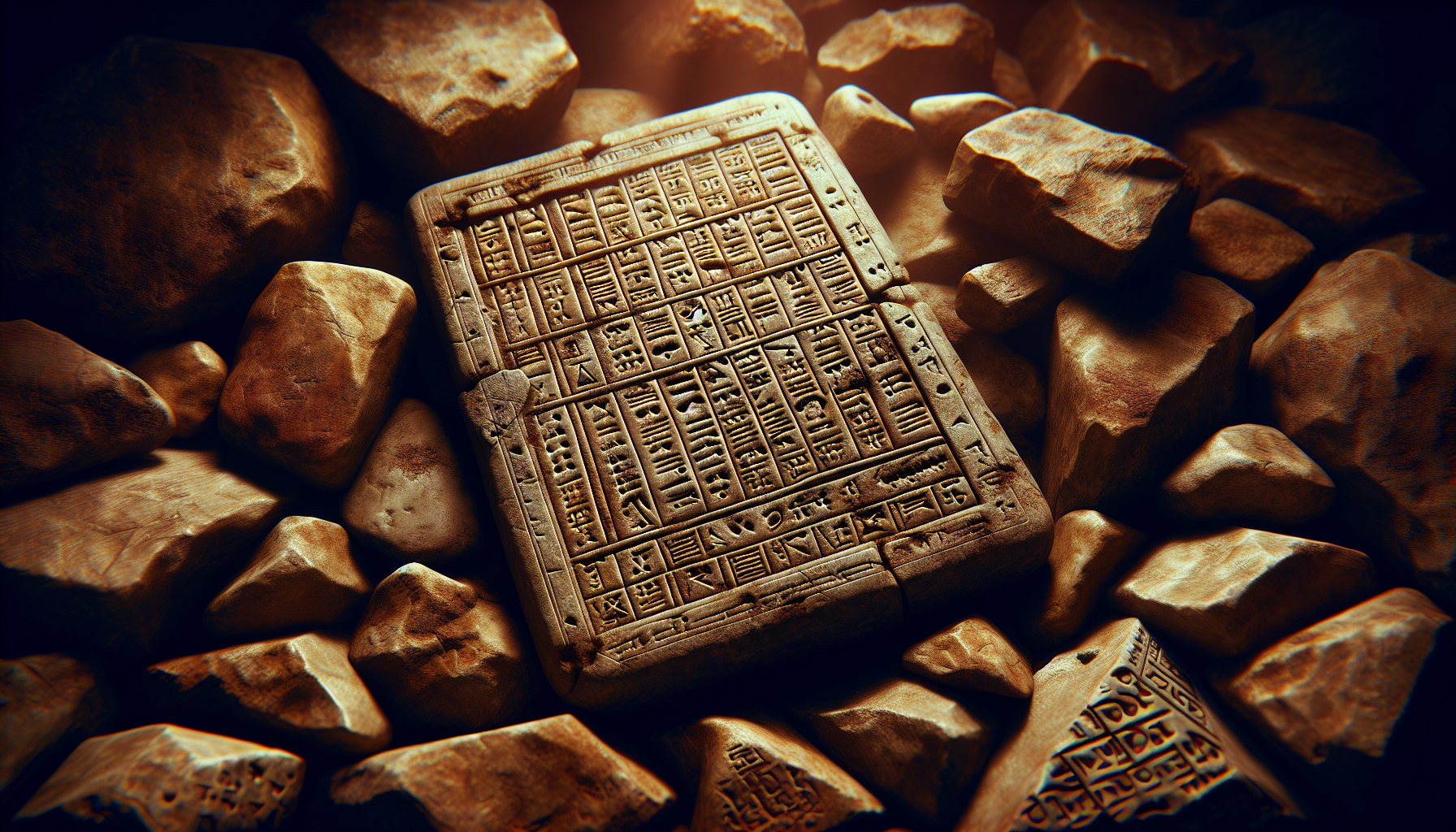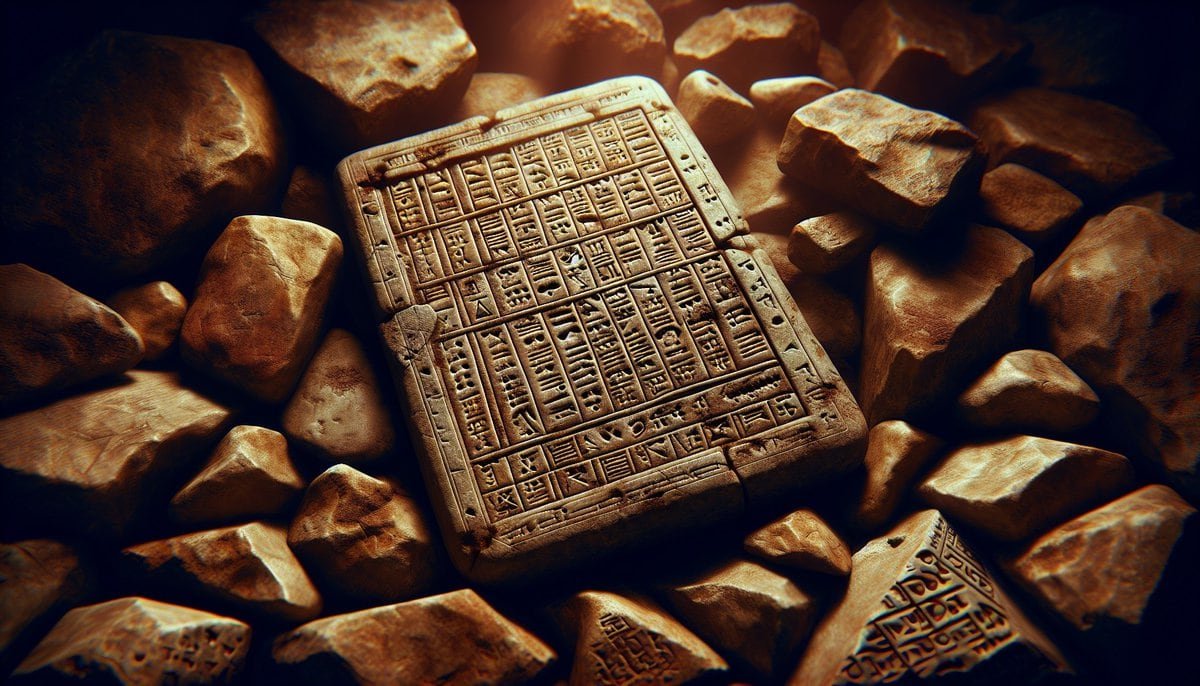In “Understanding Biblical Archaeology: Decoding the Past,” readers gain valuable insights into the world of Biblical archaeology. This article sheds light on the best ways to interpret the fascinating findings uncovered by archaeologists in their quest to understand and unravel the mysteries of the past. Discover how these ancient artifacts and sites provide a glimpse into the historical and cultural context of Biblical times, allowing us to gain a deeper understanding of the stories and events described in the Bible. Get ready to embark on a captivating journey as we explore the significance and methods behind interpreting Biblical archaeological discoveries.
Introduction to Biblical Archaeology
Defining Biblical Archaeology
Biblical archaeology refers to the scientific study and excavation of archaeological sites that have connections to the stories, events, and people mentioned in the Bible. It aims to understand and interpret the material remains of ancient civilizations to shed light on the historical, cultural, and religious contexts of biblical narratives.
Historical Background of Biblical Archaeology
Biblical archaeology has a rich history that dates back to the early 19th century when scholars began exploring the lands of the Bible. The initial objective was to seek empirical evidence to support the biblical texts and verify their historicity. Over time, the field evolved, adopting a more multidisciplinary approach that integrated various scientific methods and tools to study ancient civilizations.
Goals and Objectives of Biblical Archaeology
The main goals of biblical archaeology are to reconstruct ancient societies and cultures, understand the context of the biblical narratives, verify historical events and characters, and gain insights into the daily lives and beliefs of ancient peoples. By examining material remains, biblical archaeology seeks to bridge the gap between the biblical texts and the archaeological record.
Relationship with Religious Studies and Theology
Biblical archaeology is closely intertwined with religious studies and theology. While it operates within the realm of an empirical and scientific discipline, its discoveries and interpretations often have implications for religious beliefs and theological understandings. It provides valuable insights into the historical context of religious texts, allowing for a deeper understanding of the religious traditions and practices that emerged during ancient times.
The Importance of Biblical Archaeology
Uncovering Historical Context of Biblical Stories
One of the most significant contributions of biblical archaeology is its ability to provide historical context to the stories and events mentioned in the Bible. By excavating ancient sites and analyzing artifacts, archaeologists can reconstruct the material culture and social structures of the time, offering valuable insights into the historical accuracy of biblical narratives.
Substantiating the Existence of Biblical Characters
Through the excavation and examination of ancient tombs, inscriptions, and other archaeological findings, biblical archaeology can help provide evidence for the existence of biblical figures. While not all figures may have left behind tangible remains, discoveries like the Tel Dan Inscription, which mentions the “House of David,” have added credibility to the historical accuracy of certain biblical characters.
Providing Evidence for Key Events in Biblical Narratives
Biblical archaeology contributes valuable evidence for the occurrence of key events mentioned in the Bible. For example, the discoveries at the ancient city of Jericho and the City of David have shed light on the Israelites’ conquest of Canaan. These findings help validate the historical basis of biblical accounts and provide a clearer understanding of the contexts in which these events took place.
Shaping our Understanding of Ancient History
Biblical archaeology plays a crucial role in shaping our understanding of ancient history by uncovering and interpreting the remains of ancient civilizations. It allows us to explore and study aspects of life, such as social structures, economic systems, trade routes, and artistic expressions, that might have otherwise been lost to time. By studying these ancient cultures, we gain valuable insights into the development of human societies and their interactions.
Challenging and Confirming Historical Interpretations
The discoveries made in biblical archaeology often challenge existing historical interpretations and assumptions. By examining the archaeological record, scholars can reassess previous understandings and propose new theories. These challenges not only advance the field but also promote critical thinking and a deeper understanding of ancient cultures, their practices, and their significance to biblical studies.
Methods and Tools Used in Biblical Archaeology
Excavation Techniques and Stratigraphy
Excavation serves as a primary method in biblical archaeology. Archaeologists meticulously dig and remove layers of soil to uncover artifacts and structures. Within excavation, stratigraphy, the study of the layers or strata of deposits, is of particular importance. Understanding the relative chronology and spatial relationships of archaeological finds aids in reconstructing the history of the site.
Survey and Remote Sensing Methods
Survey methods involve systematically mapping and recording surface features and artifacts across a given landscape. This helps identify potential excavation sites and provides a broader understanding of the geographical context of ancient civilizations. Remote sensing techniques, such as aerial photography and satellite imaging, contribute to survey methodologies and assist in the identification of buried structures and archaeological sites.
Laboratory Analysis and Conservation Methods
Laboratory analysis is an essential component of biblical archaeology. Specialists analyze artifacts and samples using techniques like radiocarbon dating, elemental analysis, and microscopic examination. These analyses provide valuable insights into the composition, dating, and provenance of archaeological materials. Conservation methods are also employed to ensure the preservation and restoration of excavated artifacts for future research and display.
Digital Technologies in Biblical Archaeology
Digital technologies have revolutionized the field of biblical archaeology. Geographic Information Systems (GIS) allow for the mapping and spatial analysis of archaeological data, aiding in the interpretation and visualization of ancient sites. Three-dimensional scanning and digital reconstruction techniques enable the creation of accurate models of archaeological artifacts and structures. Additionally, database management systems provide efficient ways to store, organize, and analyze vast amounts of archaeological data.

Dating Techniques in Biblical Archaeology
Radiocarbon Dating
Radiocarbon dating is a widely used technique in biblical archaeology. It relies on the measurement of the radioactive isotope carbon-14 (^14C) present in organic material. By comparing the ratio of carbon-14 to carbon-12 in a sample to that of a known standard, archaeologists can estimate the age of the material. This dating method has helped establish the chronology of many archaeological contexts associated with biblical narratives.
Dendrochronology
Dendrochronology, or tree-ring dating, is based on the analysis of growth rings in trees. By matching tree-ring patterns from ancient timber samples with reference chronologies, dendrochronologists can determine the age of wooden artifacts or structures. This dating technique has been used to date, for example, the wooden components of ancient temples mentioned in the Bible.
Thermoluminescence Dating
Thermoluminescence dating is used to determine the age of materials that have been exposed to high temperatures. When certain minerals are heated, they absorb energy from radiation. Over time, this energy is gradually released in the form of light. By measuring the amount of light emitted, archaeologists can estimate the time since the material was last heated. Thermoluminescence dating has been used to date pottery and other heat-treated materials related to biblical contexts.
Pottery Typology and Seriation
The study of pottery plays a crucial role in dating biblical archaeological sites. Through the analysis of pottery, archaeologists can identify specific typologies and styles associated with different periods and regions. By comparing the distribution and chronology of pottery types, a relative chronological sequence can be established, aiding in dating archaeological contexts and establishing correlations with biblical events.
Key Sites and Discoveries in Biblical Archaeology
The City of Jericho
The ancient city of Jericho, located in the West Bank, has provided valuable insights into the biblical narratives, particularly the Israelites’ conquest of Canaan. Excavations led by Kathleen Kenyon in the 1950s revealed evidence of a collapsed city wall surrounding the settlement, supporting the account of its destruction described in the Book of Joshua.
The Temple Mount in Jerusalem
The Temple Mount in Jerusalem is a site of immense religious significance in Judaism and Islam. Excavations conducted by various archaeological expeditions have unearthed important artifacts, including remnants of the First and Second Jewish Temples, the Western Wall, and Solomon’s Stables. These findings contribute to our understanding of the historical and religious significance of the site.
The Dead Sea Scrolls
The discovery of the Dead Sea Scrolls in the mid-20th century near the Dead Sea revolutionized biblical scholarship. These ancient manuscripts, containing copies of biblical texts and other writings, shed light on the religious and cultural milieu of ancient Jewish communities, providing invaluable insights into the development of early Judaism.
The City of David
The City of David, located in modern-day Jerusalem, is an archaeological site that has yielded crucial evidence for biblical history. Excavations led by archaeologist Yigal Shiloh and others revealed structures, water systems, and artifacts that align with biblical descriptions of King David’s capital. These discoveries challenge and confirm historical interpretations of biblical narratives.
The Pool of Siloam
The Pool of Siloam, mentioned in the New Testament, was discovered in Jerusalem in 2004. The excavations uncovered a large stepped pool that dates back to the time of Jesus. This finding provides archaeological evidence for the location and significance of this biblical site.
The Tel Dan Inscription
The Tel Dan Inscription, discovered in northern Israel in 1993, contains an Aramaic inscription referring to the “House of David.” This inscription is the first non-biblical reference to King David, adding historical credibility to the biblical accounts and the existence of the Davidic dynasty.
The Tel Hazor Excavations
Excavations at Tel Hazor, one of the largest ancient cities in the biblical land of Canaan, have unveiled significant architectural remains and artifacts. The site provides insights into the civilizations that thrived in the region and their interactions with the Israelites during the Iron Age.
The Megiddo Archaeological Site
The ancient city of Megiddo, strategically located in present-day Israel, has been a subject of extensive archaeological study. Excavations at Megiddo have uncovered multiple layers of settlement, revealing the complexity of ancient urban life and providing insights into the interactions of various cultures mentioned in the Bible.
The Hittite Capital Hattusa
Hattusa, located in present-day Turkey, was the capital of the Hittite Empire, an ancient civilization mentioned in the Bible. Excavations at Hattusa have brought to light monumental architecture, temples, and clay tablets containing diplomatic and religious texts, enriching our knowledge of the Hittites and their relations with neighboring powers.
The Khirbet Qeiyafa Fortress
The discovery of the Khirbet Qeiyafa fortress in the Elah Valley of Israel has sparked debates and discussions within the field of biblical archaeology. Some scholars believe it to be the ancient city of Sha’arayim mentioned in the biblical account of David and Goliath. The findings at this site provide archaeological evidence for the existence of fortified cities in the region during the biblical period.
Comparing Biblical Texts with Archaeological Evidence
Methodologies for Text-Archaeology Comparative Studies
Comparing biblical texts with archaeological evidence involves a multidisciplinary approach that combines textual analysis, interpretation of archaeological findings, and historical contextualization. Scholars investigate textual references to cultural practices, historical events, and prominent figures and search for corroborating archaeological evidence to support or challenge the biblical narratives.
Examples of Text-Archaeology Correlations
There are numerous examples of correlations between biblical texts and archaeological findings. For instance, the mention of Egyptian slavery and the Exodus in the Bible has prompted archaeological research into the presence of Israelites in Egypt and their eventual departure. The discoveries at sites like Avaris and Kadesh Barnea contribute to our understanding of the historical context of these biblical accounts.
Challenges in Aligning Texts and Archaeological Findings
Aligning biblical texts with archaeological findings often presents challenges. Interpretations of both texts and artifacts may vary, and gaps in the archaeological record can make direct correlations difficult. Furthermore, different interpretations of the Bible itself and the choice of one historical narrative over another can influence the interpretation and identification of archaeological remains.
Implications for Biblical Interpretation
The alignment of biblical texts with archaeological evidence has implications for biblical interpretation. It helps scholars critically evaluate the historicity of biblical claims, identify potential biases, and gain a more nuanced understanding of the contexts in which the texts were composed. This interdisciplinary approach encourages a holistic reading of the Bible and strengthens our understanding of ancient cultures.
Controversies and Challenges in Biblical Archaeology
Dating Discrepancies and Chronological Debates
Dating discrepancies and chronological debates are common challenges in biblical archaeology. Differing interpretations and dating methods can lead to discussions about the accuracy of traditional biblical chronology. Furthermore, controversies may arise when scientific dating techniques conflict with religious or traditional beliefs.
Interpretation of Archaeological Data
Interpretation of archaeological data is a complex task, often subject to various interpretations and debates. Archaeologists must carefully analyze and contextualize their findings, taking into account the biases and perspectives they bring to their work. The interpretation of evidence can be influenced by personal beliefs, cultural background, and theoretical frameworks, leading to diverse understandings and potential controversies.
Conflicts with Religious Beliefs and National Identities
Biblical archaeology can be a contentious field due to conflicts with religious beliefs and national identities. Discoveries that challenge traditional interpretations or religious narratives can be met with resistance in religious communities. Additionally, the connection between archaeology and national identity can fuel debates and disputes over the ownership and interpretation of archaeological sites and artifacts.
Ethical Considerations in Excavation and Repatriation
Ethical considerations play a significant role in biblical archaeology, particularly regarding excavation practices and the repatriation of cultural artifacts. Archaeologists strive to conduct excavations ethically, respecting the rights and customs of local communities. Additionally, debates surround the repatriation of artifacts, raising questions about ownership, access, and the preservation of cultural heritage.
The Role of Biblical Archaeology in Understanding Ancient Cultures
Archaeological Evidence Beyond the Bible
Biblical archaeology not only focuses on the biblical narratives but also contributes to our understanding of broader ancient cultures. Excavations and analyses provide insights into the daily lives, social structures, economic systems, artistic expressions, and religious practices of various ancient civilizations. The field helps us comprehend the rich tapestry of human history beyond the biblical text.
Interactions between Israelites and other Ancient Cultures
Biblical archaeology offers glimpses into the interactions between the Israelites and other ancient cultures. The archaeological record reveals traces of trade, cultural exchange, conflicts, and diplomatic relations between the Israelites and neighboring powers such as the Egyptians, Assyrians, Babylonians, Persians, and Romans. These interactions shaped the development of ancient Israelite society and influenced biblical narratives.
Cultural Practices and Religious Beliefs
By examining archaeological remains, biblical archaeology sheds light on the cultural practices and religious beliefs of ancient civilizations mentioned in the Bible. Ritual objects, temples, altars, and burials provide insights into ancient worship practices and the diverse religious landscape of the time. These findings enhance our understanding of the religious beliefs and practices of biblical characters and their communities.
Insights into Daily Life and Material Culture
Biblical archaeology provides valuable insights into the daily lives of ancient peoples. Excavations reveal domestic structures, tools, utensils, pottery, food remains, and personal items, offering a glimpse into the daily routines, technologies, and material culture of biblical-era societies. These findings help humanize the biblical narratives, illustrating the lived experiences of individuals in ancient times.
Contributions of Biblical Archaeology to Biblical Studies
Biblical archaeology has made significant contributions to biblical studies by providing historical, cultural, and contextual frameworks for interpreting the biblical texts. By examining the material remains of ancient civilizations, scholars can explore the world in which the biblical narratives emerged, gaining a deeper understanding of their composition, literary genres, and theological underpinnings. The interdisciplinary approach of biblical archaeology enriches biblical scholarship, fostering a more comprehensive comprehension of the Bible.
Future Outlook and Advances in Biblical Archaeology
Integration of Advanced Technologies
The future of biblical archaeology is closely linked with technological advancements. Advanced imaging techniques, such as multi-spectral imaging and ground-penetrating radar, will enhance the ability to detect buried structures and artifacts. Furthermore, advancements in DNA analysis and isotope analysis will provide insights into ancient population movements, kinship networks, and dietary practices, further enriching our understanding of biblical contexts.
Collaborations with Other Disciplines
Biblical archaeology will continue to benefit from collaborations with other disciplines, such as history, anthropology, sociology, and linguistics. Interdisciplinary approaches can provide more comprehensive insights into ancient cultures and their connections to the biblical texts. Collaborative efforts foster a broader understanding of the past and encourage critical engagement with biblical narratives.
Potential Discoveries and Unanswered Questions
The field of biblical archaeology holds vast potential for new discoveries and breakthroughs. Excavations at unexplored or understudied sites may yield significant findings that challenge or confirm existing interpretations. Unanswered questions regarding biblical characters, events, and the intricacies of ancient societies provide opportunities for further exploration and research, ensuring the continuous development of the field.
Expanding Archaeological Sites and Projects
As technology and funding opportunities advance, archaeological sites and projects will expand in scope and reach. Exploration of lesser-known regions and increased collaborations with local communities will provide fresh perspectives and insight into previously understudied areas. These advancements will contribute to a more comprehensive understanding of biblical archaeology and its relevance to our understanding of the ancient world.
In conclusion, biblical archaeology plays a crucial role in decoding the past and understanding the world of the Bible. By employing various methods, tools, and dating techniques, scholars can reconstruct ancient cultures, analyze textual-archaeological correlations, and confirm historical details and events. The field of biblical archaeology not only deepens our knowledge of ancient civilizations but also enhances our understanding of the biblical narratives, contributing to scholarly endeavors and providing valuable insights into our shared human history.






